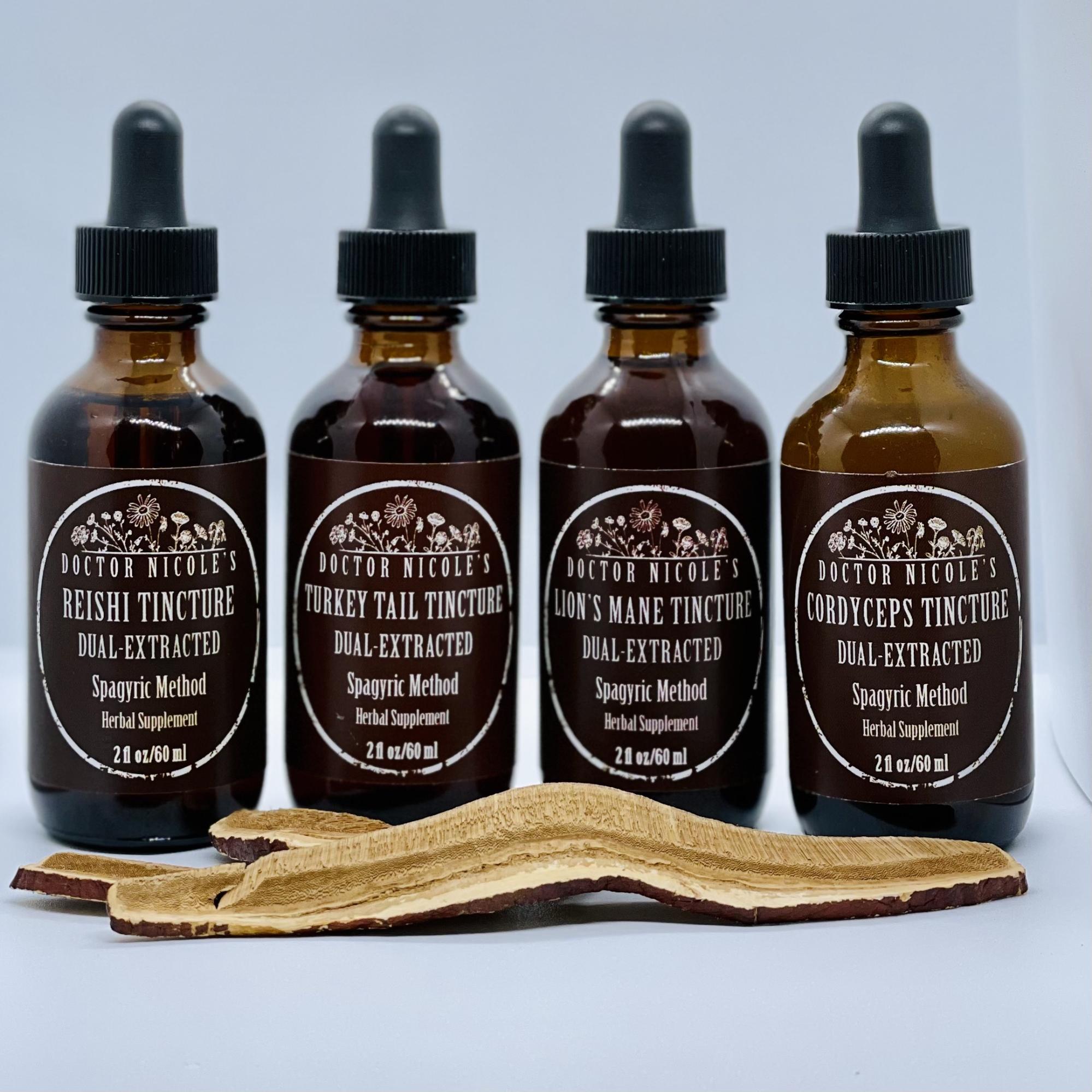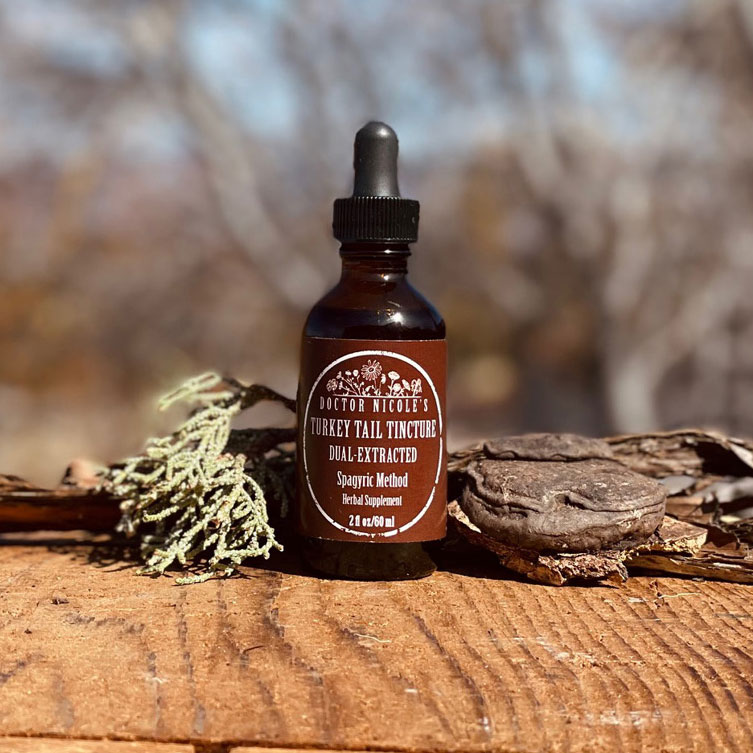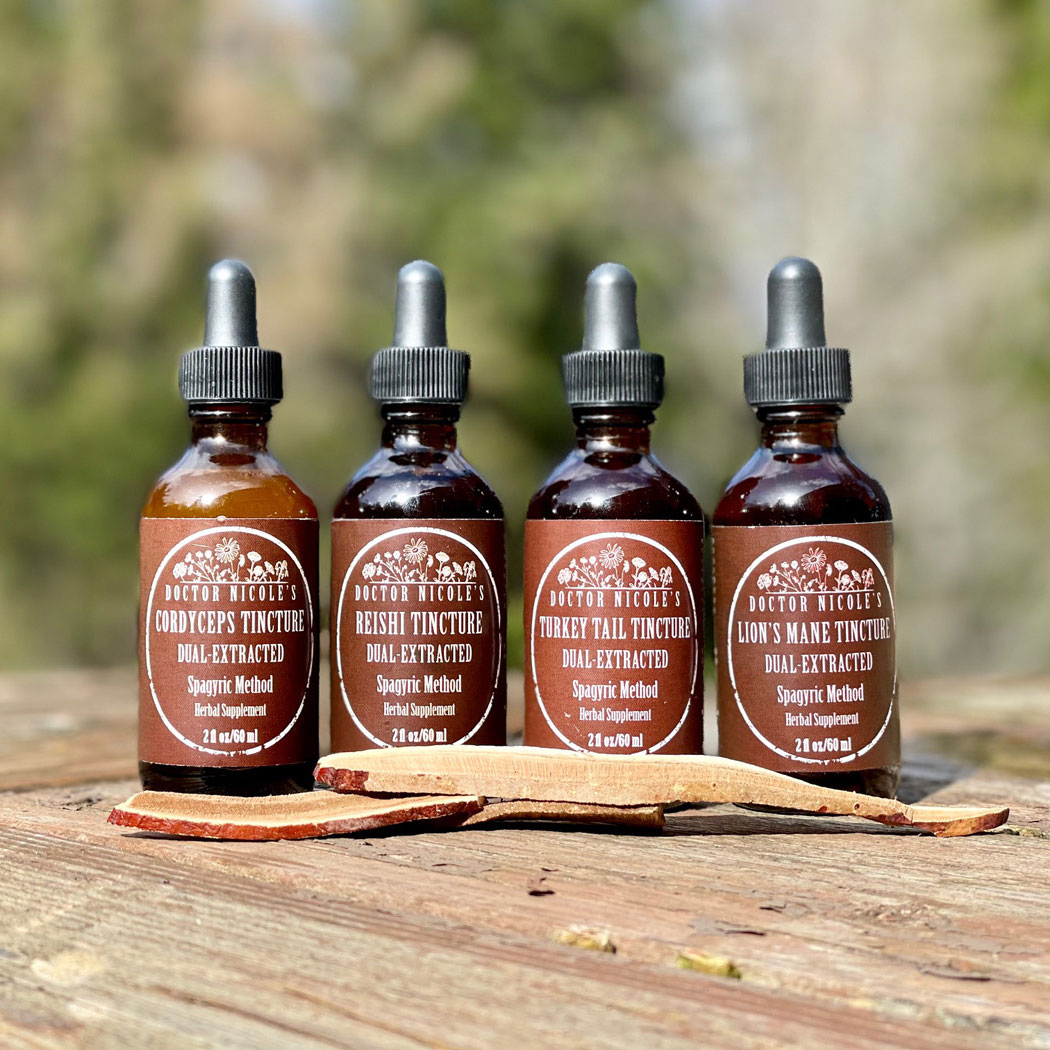Embracing Health This Holiday Season
Thanksgiving is a perfect time to celebrate one of my favorite medicinal mushrooms: turkey tail! While the holiday is often associated with an abundant meal and family gatherings, we also need to focus on fortifying immunity and health because this is one of the busiest travel times of the year — and crowded airports and festivities during the cold and flu season can mean an unwelcome guest: contagious illness. Turkey tail to the rescue! Not only does this mushroom help prevent picking up the latest bug making the rounds, but it also enhances gut health, improves immune function in those with cancer, and reduces inflammation. What’s not to love?

A Beautiful “Cloud Mushroom”
Fan-shaped with an often colorful palette of stripes that resemble the autumn colors of turkey tail feathers, there is a good chance you have crossed paths with turkey tail mushroom while walking through the woods. It grows wild on dead trees, branches, and stumps. Unlike other mushrooms, turkey tail does not have gills but instead small pores underneath that release spores. What’s more, turkey tail is found worldwide and exceedingly common. It has been utilized medicinally by Traditional Chinese Medicine for thousands of years — for good reason. Here are my favorite uses for turkey tail mushroom to keep you healthy and disease-free this Thanksgiving and beyond.
Prevents and Treats Colds, Influenza, & Severe Acute Respiratory Syndrome
Rich in polysaccharide peptide (PSP) and krestin (PSK), two polysaccharopeptides that both activate and inhibit different types of immune cells and suppress inflammation, turkey tail is known to modulate and enhance the immune system. PSP prompts white blood cells called monocytes that boost immunity and fight infection, while PSK activates dendritic cells that help to address toxins and regulate the immune system. It also stimulates natural killer cells that protect against pathogens and cancerous tumors.1,2
Turkey tail has been shown to be effective against colds, influenza, and severe viral infections that impact the lungs.3 Importantly, researchers believe the mushroom may be helpful in preventing “immunological overreaction and harmful inflammation associated with [severe acute respiratory syndrome].”3 Moreover, the bioactive compounds in turkey tail also address other viral infections, including: herpes simplex (HSV), Epstein Barr, human papillomavirus (HPV), and human immunodeficiency virus (HIV).3
Supports Gut Health
As many of you know, gut health is closely tied to immunity since gut bacteria directly influence immune response. As noted in the journal Microorganisms, “Gut dysbiosis, or negative alterations in gut microbial composition, can also dysregulate immune responses, causing inflammation, oxidative stress, and insulin resistance.”4 The researchers add, “It’s a well-known fact that the gut microbiota stimulates the normal development of the immune system and also plays a significant role in the maturation of the immune cells.”
Turkey tail contains prebiotics that help to support a healthy microbiome by increasing beneficial bacteria, such as Bifidobacterium and Lactobacillus, and reducing harmful bacteria like Clostridium and Staphylococcus.5,6 Studies have established that healthy levels of Bifidobacterium and Lactobacillus in the gut are directly associated with a robust immune system as well.
Fights Cancer
Need another reason to try turkey tail? The mushroom may help to prevent and address several types of cancer. As noted above, turkey tail is brimming with PSK and PSP — two compounds that boost the immune system to fight tumors. It is also high in antioxidants to reduce DNA damage cause by oxidative stress, thereby helping to lower the risk of cancer.8 Researchers have found that turkey tail is outstanding for treating cancers of the breast, colon, and lung, along with leukemia and melanoma.10,11,13,14,15 Moreover, it was shown to improve longevity and reduce the side effects of conventional cancer treatments.9,12
Seeking additional benefits? Dual-extracted turkey tail mushroom is also helpful for malaria, chronic fatigue syndrome, blood sugar issues, candida overgrowth, and modulating the immune system in those with autoimmunity.
The Gold Standard of Medicinal Mushroom Extracts
With all the exceptional benefits of turkey tail mushroom, it is important to use only the most potent and effective tinctures for the best results. This is why I developed our dual-extracted turkey tail tincture with the fruiting body of the mushroom — not the lower-quality mycelium. Why is this important?
Many manufacturers grow mycelium, which is an earlier stage of the mushroom that is grown on grains. When the fungi is processed, much of the grain is included—and little of the actual mushroom. This results in a substandard product that is high in grain starch and low in beneficial mushroom compounds such as beta-glucans.
Don’t be fooled by products that claim to be mushrooms, but are actually mostly grains. It is crucial to use mushroom extracts that are made from the high-quality fruiting body as it yields a superior medicinal product containing 30-40 percent beta-glucans, compared to mycelium extracts, which typically only have 5-7 percent. The higher the beta-glucans, the higher the benefit for boosting and regulating the immune system, improving glucose levels, supporting cardiovascular health, and more.
You can learn more about what sets our herbal medicines apart here.
THE BEST NATURAL REMEDIES
“As with any product you try for the first time, I began taking the mushroom tinctures with a bit of trepidation. I ordered the FOURtress Bundle in hopes that it will help me with Fibromyalgia symptoms and RA. About a week before ordering this tinctures bundle, I started having pain in my maxilla, mandibula and in my eye. All on the left side. This disease is nicknamed the suicide disease, and for good reason; Trigeminal Neuralgia pain drives you insane. As I started taking the mushroom tinctures, I suddenly realized the pain in my face, eye and year subsided and eventually went away completely.
I want to warn you about something. When I finished them, I looked for and purchased the same tinctures from other merchants because they cost a bit less than Nicole’s. I started taking them in the same dose, but, surprise, the pain started coming back. I increased the dose a couple of times and finally they started working.
So, please don’t go elsewhere for a “better price”. You have nothing to gain since they are not as potent as Nicole’s. Of course I returned to her products. Please read the extraction method she uses and you will understand why her products are more potent.” -Gabriella M.
Don’t settle for less than optimal health. Discover how our natural and effective extracts and salves can help you achieve your wellness goals. Visit my apothecary today and feel the difference!
Nicole Apelian
Nicole’s Apothecary Products in this Post
References
- Saleh, M. H., Rashedi, I., & Keating, A. (2017). Immunomodulatory Properties of Coriolus versicolor: The Role of Polysaccharopeptide. Frontiers in immunology, 8, 1087. https://doi.org/10.3389/fimmu.2017.01087
- Lu, H., Yang, Y., Gad, E., Inatsuka, C., Wenner, C. A., Disis, M. L., & Standish, L. J. (2011). TLR2 agonist PSK activates human NK cells and enhances the antitumor effect of HER2-targeted monoclonal antibody therapy. Clinical cancer research : an official journal of the American Association for Cancer Research, 17(21), 6742–6753. https://doi.org/10.1158/1078-0432.CCR-11-1142
- Jędrzejewski, T., Pawlikowska, M., Sobocińska, J., & Wrotek, S. (2023). COVID-19 and Cancer Diseases-The Potential of Coriolus versicolor Mushroom to Combat Global Health Challenges. International journal of molecular sciences, 24(5), 4864. https://doi.org/10.3390/ijms24054864
- Yoo, J. Y., Groer, M., Dutra, S. V. O., Sarkar, A., & McSkimming, D. I. (2020). Gut Microbiota and Immune System Interactions. Microorganisms, 8(10), 1587. https://doi.org/10.3390/microorganisms8101587
- Saleh, M. H., Rashedi, I., & Keating, A. (2017). Immunomodulatory Properties of Coriolus versicolor: The Role of Polysaccharopeptide. Frontiers in immunology, 8, 1087. https://doi.org/10.3389/fimmu.2017.01087
- Yu, Z. T., Liu, B., Mukherjee, P., & Newburg, D. S. (2013). Trametes versicolor extract modifies human fecal microbiota composition in vitro. Plant foods for human nutrition (Dordrecht, Netherlands), 68(2), 107–112. https://doi.org/10.1007/s11130-013-0342-4
- Shi, L. H., Balakrishnan, K., Thiagarajah, K., Mohd Ismail, N. I., & Yin, O. S. (2016). Beneficial Properties of Probiotics. Tropical life sciences research, 27(2), 73–90. https://doi.org/10.21315/tlsr2016.27.2.6
- Janjušević, L., Karaman, M., Šibul, F., Tommonaro, G., Iodice, C., Jakovljević, D., & Pejin, B. (2017). The lignicolous fungus Trametes versicolor (L.) Lloyd (1920): a promising natural source of antiradical and AChE inhibitory agents. Journal of enzyme inhibition and medicinal chemistry, 32(1), 355–362. https://doi.org/10.1080/14756366.2016.1252759
- Habtemariam S. (2020). Trametes versicolor (Synn. Coriolus versicolor) Polysaccharides in Cancer Therapy: Targets and Efficacy. Biomedicines, 8(5), 135. https://doi.org/10.3390/biomedicines8050135
- Lowenthal, R., Taylor, M., Gidden, J. A., Heflin, B., Lay, J. O., Jr, Avaritt, N., Tackett, A. J., & Urbaniak, A. (2023). The mycelium of the Trametes versicolor synn. Coriolus versicolor (Turkey tail mushroom) exhibit anti-melanoma activity in vitro. Biomedicine & pharmacotherapy = Biomedecine & pharmacotherapie, 161, 114424. https://doi.org/10.1016/j.biopha.2023.114424
- Torkelson, C. J., Sweet, E., Martzen, M. R., Sasagawa, M., Wenner, C. A., Gay, J., Putiri, A., & Standish, L. J. (2012). Phase 1 Clinical Trial of Trametes versicolor in Women with Breast Cancer. ISRN oncology, 2012, 251632. https://doi.org/10.5402/2012/251632
- Zhong, L., Yan, P., Lam, W. C., Yao, L., & Bian, Z. (2019). Coriolus Versicolor and Ganoderma Lucidum Related Natural Products as an Adjunct Therapy for Cancers: A Systematic Review and Meta-Analysis of Randomized Controlled Trials. Frontiers in pharmacology, 10, 703. https://doi.org/10.3389/fphar.2019.00703
- Hsieh, T. C., & Wu, J. M. (2013). Regulation of cell cycle transition and induction of apoptosis in HL-60 leukemia cells by the combination of Coriolus versicolor and Ganoderma lucidum. International journal of molecular medicine, 32(1), 251–257. https://doi.org/10.3892/ijmm.2013.1378
- Roca-Lema, D., Martinez-Iglesias, O., Fernández de Ana Portela, C., Rodríguez-Blanco, A., Valladares-Ayerbes, M., Díaz-Díaz, A., Casas-Pais, A., Prego, C., & Figueroa, A. (2019). In Vitro Anti-proliferative and Anti-invasive Effect of Polysaccharide-rich Extracts from Trametes Versicolor and Grifola Frondosa in Colon Cancer Cells. International journal of medical sciences, 16(2), 231–240. https://doi.org/10.7150/ijms.28811
- Fritz, H., Kennedy, D. A., Ishii, M., Fergusson, D., Fernandes, R., Cooley, K., & Seely, D. (2015). Polysaccharide K and Coriolus versicolor extracts for lung cancer: a systematic review. Integrative cancer therapies, 14(3), 201–211. https://doi.org/10.1177/1534735415572883








